| Revision as of 14:32, 22 March 2009 editCydebot (talk | contribs)6,812,251 editsm Robot - Moving category Jefferson administration to Presidency of Thomas Jefferson per CFD at Misplaced Pages:Categories for discussion/Log/2009 March 16.← Previous edit | Revision as of 15:30, 10 April 2009 edit undo82.4.220.242 (talk)No edit summaryNext edit → | ||
| Line 17: | Line 17: | ||
| | electoral_vote1 = 162 | | electoral_vote1 = 162 | ||
| | states_carried1 = '''15''' | | states_carried1 = '''15''' | ||
| | popular_vote1 = 104,110 | | popular_vote1 = '''104,110''' | ||
| | percentage1 = 72.8% | | percentage1 = '''72.8%''' | ||
| | image2 = ] | | image2 = ] | ||
| | nominee2 = ] | | nominee2 = ] | ||
Revision as of 15:30, 10 April 2009
| |||||||||||||||||||||||||||||
| |||||||||||||||||||||||||||||
 Presidential election results map. Green denotes states won by Jefferson, orange denotes states won by Pinckney. Numbers indicate the number of electoral votes allotted to each state. Presidential election results map. Green denotes states won by Jefferson, orange denotes states won by Pinckney. Numbers indicate the number of electoral votes allotted to each state. | |||||||||||||||||||||||||||||
| |||||||||||||||||||||||||||||
The United States presidential election of 1804 pitted incumbent Democratic-Republican President Thomas Jefferson against Federalist Charles Cotesworth Pinckney. Jefferson easily defeated Pinckney in the first presidential election conducted following the ratification of the Twelfth Amendment to the United States Constitution.
Under the rules of the Twelfth Amendment, presidential electors were required to specify in their votes their choice for President and Vice President; previously, electors voted only for President, with the person who came in second becoming the Vice President. George Clinton was elected Vice President and went on to serve under both Jefferson and his successor, James Madison.
Jefferson's 45.6 percentage point victory margin remains the highest victory margin in a presidential election in which there were multiple major party candidates.
Background
Although the 1800 election had been close, Jefferson had steadily gained popularity during his term. American trade had boomed because the French Revolutionary Wars in Europe had been temporarily suspended. The Louisiana Purchase was heralded as a great achievement.
Nominations
Democratic-Republican Party nomination
- Thomas Jefferson, President of the United States from Virginia
Candidates gallery
Jefferson was renominated and Governor George Clinton of New York replaced Aaron Burr as his running mate.
| Presidential Ballot | Vice Presidential Ballot | ||
|---|---|---|---|
| Thomas Jefferson | 108 | George Clinton | 67 |
| John Breckinridge | 20 | ||
| Levi Lincoln | 9 | ||
| John Langdon | 7 | ||
| Gideon Granger | 4 | ||
| William Maclay | 1 |
Federalist Party nomination
- Charles C. Pinckney, former U.S. Minister to France from South Carolina
Candidate gallery
The Federalists chose Pinckney and former United States Senator Rufus King of New York to run against him.
General election
Attacks on Jefferson's policies proved fruitless; Jefferson's victory was overwhelming, even winning most of the states in the Federalist heartland of New England.
Results
| Presidential candidate | Party | Home state | Popular vote | Electoral vote |
Running mate | |||
|---|---|---|---|---|---|---|---|---|
| Count | Percentage | Vice-presidential candidate | Home state | Electoral vote | ||||
| Thomas Jefferson | Democratic-Republican | Virginia | 104,110 | 72.8% | 162 | George Clinton | New York | 162 |
| Charles C. Pinckney | Federalist | South Carolina | 38,919 | 27.2% | 14 | Rufus King | New York | 14 |
| Total | 143,029 | 100% | 176 | 176 | ||||
| Needed to win | 89 | 89 | ||||||
Source (Popular Vote): U.S. President National Vote. Our Campaigns. (February 10, 2006).
Source (Electoral Vote): "Electoral College Box Scores 1789–1996". National Archives and Records Administration. Retrieved July 30, 2005.
Only 11 of the 17 states chose electors by popular vote.
Those states that did choose electors by popular vote had widely varying restrictions on suffrage via property requirements.
Electoral college selection
| Method of choosing electors | State(s) |
|---|---|
| Each Elector appointed by state legislature | Connecticut Delaware Georgia New York South Carolina Vermont |
| Each Elector chosen by voters statewide | New Hampshire New Jersey Ohio Pennsylvania Rhode Island Virginia |
| State is divided into electoral districts, with one Elector chosen per district by the voters of that district | Kentucky Maryland North Carolina Tennessee |
|
Massachusetts |
See also
References
- "A Historical Analysis of the Electoral College". The Green Papers. Retrieved March 20 2005.
{{cite web}}: Check date values in:|accessdate=(help); Unknown parameter|dateformat=ignored (help) - A New Nation Votes: American Election Returns 1787-1825


